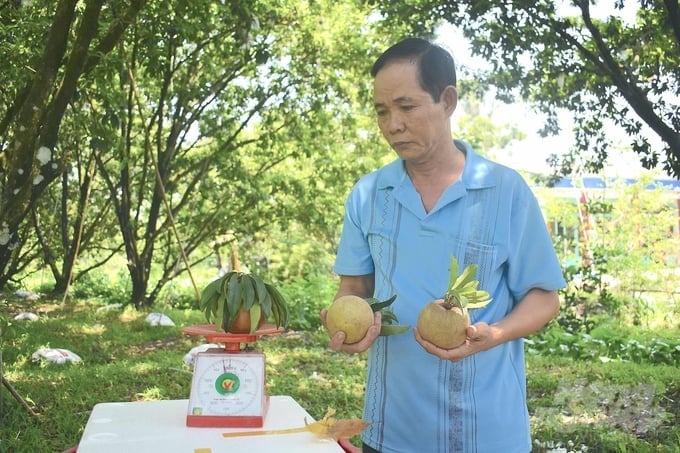November 27, 2025 | 22:23 GMT +7
November 27, 2025 | 22:23 GMT +7
Hotline: 0913.378.918
November 27, 2025 | 22:23 GMT +7
Hotline: 0913.378.918
More than 10 years ago, by chance during a party in Ben Tre province, Mr Kha discovered this sapoche variety. After trying it, feeling the delicious taste as well as the potential for growth in his garden, he boldly ordered 25 seedlings to test plant on 1,000m2.

Mr Tran Van Kha pioneered planting Mexican sapoche varieties in Song Thuan commune, Chau Thanh district, Tien Giang province. Photo: Minh Dam.
After 3 years of care, the tree has begun to bear fruit, but it is not until the 5th year that it produces much yield, an average of about 50 - 60kg/tree. The older the tree, the higher the yield. Mexican Sapoche is easy to grow, has few pests and diseases, and upkeep costs are only 50% compared to regular sapoche varieties.
This variety of sapoche produces very large fruits, weighing from 250 - 700g, round, soft, with bran-like skin, very sweet and long-lasting aroma, the deliciousness is considered the most outstanding among all types of sapoche. Therefore, over the past 10 years, Mexican sapoches have been purchased by traders at prices ranging from VND 55,000 - 60,000/kg, 2 - 3 times higher than jam sapoches - a native sapoche variety.
Realizing the economic efficiency of this sapoche variety, Mr Kha decided to expand the area, planting about 150 more trees on 7,000 square meters, of which 5,000 square meters produced stable fruit.
Currently, Mr Kha's sapoche trees are over 10 years old, yielding up to 200 kg/tree and generating an income of VND 300 million/year. Particularly for the 5,000m2 of expanded planting that is bearing fruit, Mr Kha's family earns nearly VND 400 million each year.

Mexican sapoches are very large, weighing an average of 400g. Photo: Minh Dam.
Talking about effective Mexican sapoche planting techniques, Mr Kha shared: In order for the tree to grow well, it is necessary to build a high, dry dune with good drainage. When first planted, it is necessary to water sapoches with growth stimulants to nourish healthy roots. After that, we just apply normal chemical and organic fertilizers according to the age of the tree. During the business period, it is necessary to apply adequate chemical and organic fertilizers for plants to grow sustainably. Each year, about 7kg of chemical fertilizer and 20kg of organic fertilizer are needed for each root. In each period of young shoots, flowering, and fruiting, it is necessary to guard against pests and mealybugs.
Sapoche is one of the crops that can withstand drought and salinity very well compared to many other crops. According to the Department of Agriculture and Rural Development of Tien Giang province, along with coconut, tamarind and grapes, sapoche is a group of trees that are resistant to salinity, and able to withstand salinity concentrations of 5‰ - 6‰.
To prevent saltwater intrusion for sapoche trees, Mr. Kha said that during the dry season, ditches must be dredged to prepare water and irrigate economically, cover the base with straw, grass, and coconut shells to prevent water evaporation and heat for the tree.

Water sparingly for sapoches in the dry season. Photo: Minh Dam.
Song Thuan commune, Chau Thanh district (Tien Giang) has nearly 520 ha of agricultural land, people grow mainly sapoche and coconut trees. Ms Nguyen Thi Hoang Yen, Vice Chairwoman of Song Thuan Commune People's Committee commented: Mr Tran Van Kha's Mexican sapoche planting model is one of the models for converting production to new plant varieties that bring quite high efficiency. It is being studied and replicated by local people in an area of about 5 ha.
Currently, the price of type I Mexican sapoche is VND 60,000/kg, and the price for the small type is VND 18,000/kg. The effectiveness of this sapoche planting model is 3 times higher than that of regular sapoche. In addition to harvesting fruit every year, Mr Kha also branches sapoche to sell about 1,000 branches/year, bringing his family an income of several hundred million VND/year.
Sapoche is one of the famous crops in communes along the Tien River of Tien Giang province, especially in localities such as Kim Son, Phu Phong, and Song Thuan with an estimated area of about 1,500 ha. The Mexican sapoche variety will contribute to diversifying crop varieties for local people when choosing to develop their agricultural economy. Mr. Tran Van Kha's model is being widely replicated by local people.
Translated by Hoang Duy

(VAN) On November 27, in the meeting with Minister Tran Duc Thang, Mayor Yin Yong shared Beijing’s experience to improve environment and air quality.

(VAN) After 30 years, both sides identified strategic areas of cooperation: sustainable production, increasing coffee value and training for farmers.
/2025/11/27/4910-4-164708_294.jpg)
(VAN) On the afternoon of November 27 in Beijing, Minister of Agriculture and Environment Tran Duc Thang held a working session with several major Chinese enterprises operating in the agriculture and environment sector.

(VAN) The Department of Animal Health issued a provisional guideline requesting local authorities to increase surveillance, collect samples for testing, and conduct epidemiological investigations according to the established procedure.

(VAN) The United Nations recommends that Vietnam utilize data and artificial intelligence to enhance early disaster warnings and reduce GDP losses by 3.2% in the context of climate change.

(VAN) On the morning of November 27 in Beijing, Minister Tran Duc Thang and the Deputy Commissioner General of the General Administration of Customs of China signed a protocol on fresh jackfruit exports.

(VAN) As floodwaters recede, a vast network of irrigation works across eastern Gia Lai is emerging in a state of severe disrepair, with extensive damage demanding urgent restoration ahead of the 2025-2026 winter-spring cropping season.